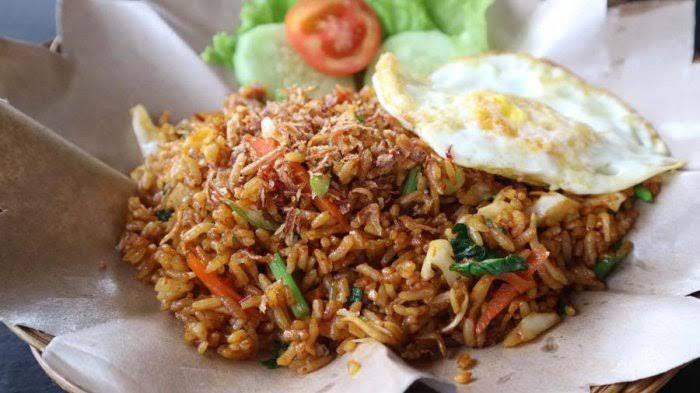Popular Reads
Top Results
Can't find what you're looking for?
View all search resultsPopular Reads
Top Results
Can't find what you're looking for?
View all search resultsIndonesian Icons: ‘Nasi Goreng tek-tek’ – that one food every Indonesian loves
Change text size
Gift Premium Articles
to Anyone
N
asi goreng tek-tek, the street food version of fried rice, is that one dish enjoyed by every Indonesian regardless of background.
When in doubt, just order a plate of nasi goreng tek-tek. As a street food, nasi goreng tek-tek. A variant of Indonesian fried rice, it is named so because of the clanging “tek tek” sound its sellers make when hitting their skillet onto the pan to attract customers and when they are frying.
As street food, its relatively cheap price point is one of the reasons for its persistent popularity, but more than that, its positioning as “everyone’s dish” is not just figurative but literal. Nasi goreng tek-tek is almost-exclusively sold by a single seller on a modest wooden cart which either sets up in a busy area that is comfortable for “hanging out” or goes around neighborhoods – from slums to upper-class ones. (So much so, that one grievance often uttered by those living in the increasingly common gated neighborhoods or “clusters” that do not allow carts to come inside, is the inability to buy from nasi goreng tek-tek sellers right on their doorstep).
To reiterate – it is a food for everyone.
Just ask 40-year-old Ivan Wanara, who has been running a nasi goreng stall in Canggu, Bali since 2007.
“From construction workers to motorcycle taxi drivers, from those who drive [fancy cars] to Jakarta visitors [in Bali]. It is a simple dish and so cheap. It’s the food of the people,” said Ivan, who is originally from Pemalang, Central Java.
“For Indonesians, unless you eat rice, you’re still hungry [no matter what you eat],” he added.
Ivan, who previously worked as a driver, decided to become an abang nasi goreng (Indonesian phrase for street fried rice seller) because it was so mainstream and was a sure-fire choice for customers.
He opens the stall every day from 6 p.m. to 1 a.m. and, despite experiencing a slow in business since the COVID-19 pandemic, Ivan acknowledged that he still sees people come and go to fill their stomach with nasi goreng tek-tek.
Ivan runs the stall with his colleague, Johan Apandi, 23, who is also from Pemalang and was introduced to Ivan through a friend. Despite being quite young, Johan shows a finesse in frying the rice with vegetables, meat and cooking oil as if he could do it in his sleep.
“I’ve known how to cook nasi goreng since I was 18,” he said.
Way of life
Twenty-seven-year-old Felicia Alvina, an IT consultant based in Jakarta who currently works from Bali, enjoyed a variation of nasi goreng tek-tek at Ivan’s stall after watching a game of tennis on Thursday evening. Felicia asked for a sunny side egg and additional fried noodles to her nasi goreng.
“For me nasi goreng is basically a way of life,” she said with a laugh, adding, “You can eat nasi goreng anytime from breakfast, lunch, supper and dinner.”
Indonesian fried rice, typically cooked with pieces of meat and vegetables, is a popular local dish known for its smoky aroma and sweet yet savory flavor. It is also known for its simplicity when it comes to preparation.
There is no one definitive recipe for nasi goreng. This is due to the fact that anybody can pretty much recreate nasi goreng based on their own creativity and the dish allows any kind of ingredients and toppings.
Most nasi goreng, however, features three parts that can be generally found in each plate: ingredients (cooking oil, vegetables, pieces of meat, sweet soy sauce), bumbu (spices - the basics comprising garlic, chili pepper, and salt), and condiments (slices of tomato and cucumber and fried shallots).
Almost all Indonesians agree that nasi goreng tastes better when the rice is leftover from the day before rather than freshly cooked.
The fact that nasi goreng is traditionally cooked using mostly leftovers makes the dish symbolize resilience and resourcefulness. The easy-going nature of nasi goreng when it comes to cooking methods also symbolizes Indonesians’ ability to roll with the punches no matter how many lemons (or in this case, how much leftover rice) are thrown at them.
Back to the roots
Indonesian language teacher Daniel Prasatyo, 42, who is based in Ubud, Bali, commented that nasi goreng tek-tek is the middle ground, the fail-safe solution for groups when they eat out or hang out.
“Indonesians [mostly] eat rice. When hanging out with friends, you can have nasi goreng in any variety from plain, spicy, vegetarian, with seafood, chicken, eggs, or anything. Let's say the majority of a group of five want to have seafood. One is allergic to seafood. Nasi goreng with eggs is the solution,” said Daniel, adding that if one of the group members is vegetarian, they can just order a plain nasi goreng with vegetables.
“You can actually have a good time hanging out with your buddies without having arguments about whether one diet is better than the other,” he said.
The use of leftover rice for nasi goreng goes back to the origin of the food. It is interesting to note that nasi goreng is not native to Indonesia. According to Denpasar-based editor for a gourmet and lifestyle publication Eve Tedja, nasi goreng was invented by Chinese people in the past because they did not want to throw away any leftovers.
“[They] found an ingenious way to put various ingredients together and make an altogether new, tasty dish. Through centuries of trade and immigration, this frugal invention is now enjoyed in different countries,” the 35-year-old food writer told The Jakarta Post in an interview.
A properly cooked nasi goreng with high heat in a wok would result in the sweet soy sauce caramelizing the rice, lending it that seductive, charred and slightly smoky aroma of nasi goreng, Eve Tedja added.
“An image of abang nasi goreng [fried rice seller] expertly throwing his wok on top of roaring fire immediately comes to mind,” she said.
Many abang nasi goreng have their own “secret sauce” in their mise-en-place, according to Eve. This combination of “secret sauce” or spices and herbs with sweet soy sauce are the foundation of Javanese nasi goreng.
“That is only one example because it will be different in Aceh, Bali and other regions in Indonesia,” she said.
A dedicated seller: Charli, 46, originally from Subang, West Java , has been selling 'nasi goreng' since 2005. (Courtesy of Veronica Wilson) (Personal Collection/Courtesy of Veronica Wilson)A nasi goreng seller named Charli, 46, originally from Subang, West Java, agreed with Eve. Having been selling nasi goreng since 2005, Charli noted that each province had its own spin of the fried rice menu and that many Indonesians perceived the dish as a staple food.
“Nasi goreng has many fans,” stated Charli, adding that many nasi goreng sellers form their own organization to support each other. “But there are nasi goreng sellers who become lone wolves.”
Midnight savory
Like many Indonesians, Veronica Hanny Arsanty, 47, and her husband Wilson Panjaitan, 48, would pick nasi goreng any time of the day because of its comforting taste, simplicity and availability.
“Nasi goreng is always reliable when you’re hungry in the middle of the night. Most nasi goreng sellers are open until 1 a.m. or even 2 a.m. For people who don’t live near a 24/7 fast-food chain, nasi goreng is a convenient choice,” said Veronica, who is based in Depok, West Java.
Veronica commended nasi goreng for its variety. Her personal favorite is nasi goreng ati ampela (fried rice with chicken liver and gizzard), while Wilson’s nasi goreng of choice is nasi goreng petai (fried rice with stinky beans).
“Indonesia’s nasi goreng is distinctive because we use sweet soy sauce. That’s why it becomes so iconic among Indonesians,” said Veronica.
For the couple, nasi goreng is a safe option whenever they visit a new restaurant and become unsure of what to order. They also have a favorite nasi goreng stall near their house that they often visit.
Veronica and Wilson are not the only nasi goreng aficionados.
Nasi goreng aficionados: For Veronica Hanny Arsanty, 47, and her husband Wilson Panjaitan, 48, 'nasi goreng' is a safe option to order anytime of the day. (Courtesy of Veronica Wilson) (Personal Collection/Courtesy of Veronica Wilson)Johanna Aritonang, 30, a Jakarta-based analyst said nasi goreng was simply a delicious choice that was not only filling but also could be eaten by anyone due to its variety.
“Even vegans can enjoy the dish because you can simply play around with the recipe. Nasi goreng is never wrong,” she said, adding that kerupuk (fish or prawn crackers) is the perfect complement for nasi goreng.
Authenticity
Fried rice is not only easily found in Indonesia but also in many Asian cultures. When asked about the popularity of fried rice across the region, Eve believed that the popular dish is a symbol of a “make-do approach to eating.”
“I think in our current paradoxical era where political starvation and shameful food excess exist side-by-side, we have to reflect and appreciate this wise ingenuity. Can we invent another simple, versatile and tasty dish like nasi goreng to cut our food waste?” she said.
In July last year, Dwi Larasatie Nur Fibri, a culinary expert from the Department of Agricultural Technology at Gadjah Mada University in Yogyakarta, presented her findings that there are at least 104 variations of nasi goreng in Indonesia where the origins of 36 of these variations could be traced while the rest could not.
Insight: Denpasar-based food writer Eve Tedja shares that 'nasi goreng' was invented by Chinese people in the past because they did not want to throw away any leftovers. (Courtesy of Eve Tedja) (Personal Collection/Courtesy of Eve Tedja)Commenting on the findings, Eve said that it is ‘tricky’ to define nasi goreng in Indonesia.
“From Aceh’s spicy version to Makassar’s tomato-sauced take. But perhaps, it is what makes our cuisine distinctive,” she said.
Eve highlighted nasi goreng tek-tek in particular because, as the ultimate comfort food, it will never go out of fashion.
“[Nasi goreng] is something familiar that we grow up eating at home and outside. Rice, being the staple food of Indonesia, is another factor. Most of us still consider that no meal is real without the presence of rice. Nasi goreng is a combo, a practical and affordable complete meal in one dish,” Eve said.














